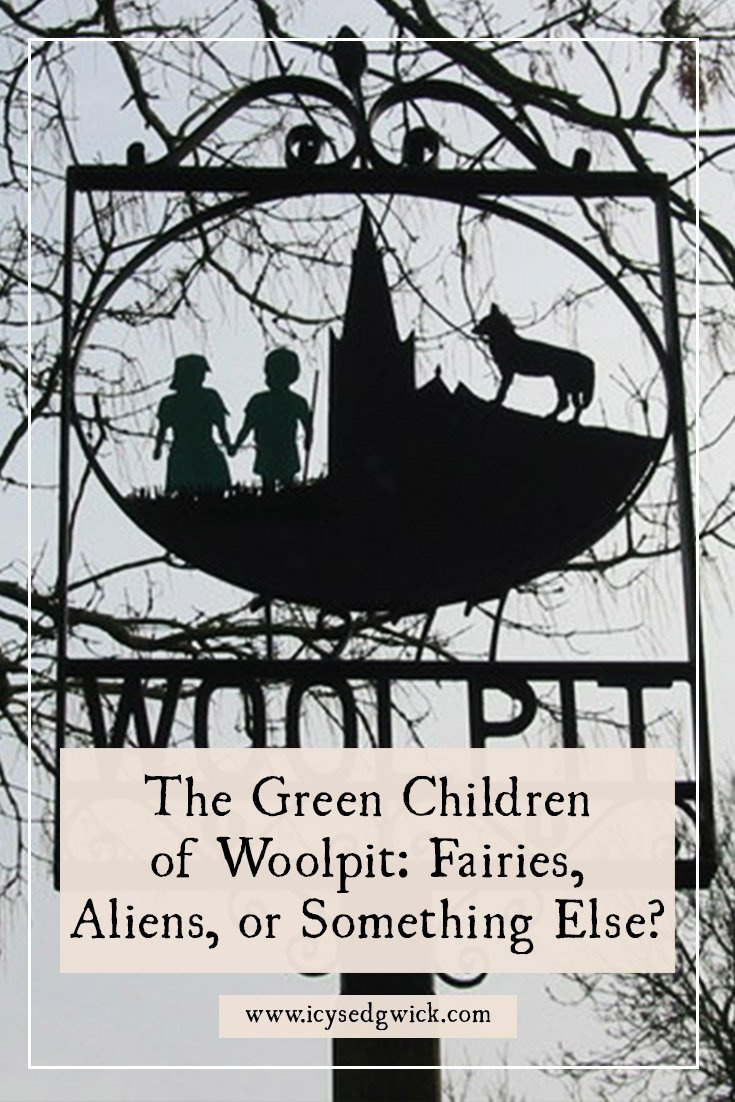According to legend, two green children wandered into a village in 12th-century Suffolk. No one knew who they were or where they came from. Their refusal to eat and unfamiliar language made locals wary. Over time, they gradually assimilated, and told a fantastic story of their origins.
Were they fairies? Lost children with big imaginations? Extraterrestrials? The fever dream of medieval chroniclers?
Let’s take a look!
The Legend
The story takes us to Woolpit in Suffolk. Its Old English name was ‘Wulfpytt’ since it had a pit to catch wolves. The village also has another odd claim to fame, since people conducted pilgrimages there in the medieval era. They wanted to visit Our Lady of Woolpit’s well, behind the church. Apparently, it healed eye diseases (Westwood 2005: 707).

But back to the legend.
Ralph of Coggeshall, a monk in Essex, included the story in his Chronicon Anglicanum, dating it to ‘within living memory’. In it, the villagers discovered two green-skinned children near the wolf pit. Acting strangely, they spoke in an unintelligible language. The villagers took them to Sir Richard de Calne’s home, but they repeatedly refused food. Unsure what to do with them, Sir Richard gave them the run of the house. A few days after they arrived, they discovered green beans in the garden and happily tucked in (Johnson, no date).
The children stayed there for a few years. Over time, they gradually began to eat a wider range of food. The less green food they ate, the more they lost their green skin tone. Sir Richard also taught them English, and eventually, someone asked them where they’d come from.

They didn’t know how they’d ended up in Suffolk. It seems they’d travelled through a cavern to get there.
Stories of people passing through caves and ending up in the Otherworld are not unique in folklore. Gervase of Tilbury recalled a tale in which a swineherd in Derbyshire entered Peak Cavern looking for a pig when he ended up in a land in which the seasons were inverted. In Northumberland, we also have the legend of Hen Hole, in which the cavern apparently leads to the Otherworld, although the local fairies are more likely to lure you in with music than you are to wander in by accident.
Other Variations
The 12th-century chronicler William of Newburgh also wrote about the story. You might remember William of Newburgh as a bit of a friend of the podcast, having also recorded the legends of the Alnwick, Berwick, and Melrose vampires, and a fairy encounter near Willy Howe.
Some sources suggest that William of Newburgh got his version from Ralph of Coggeshall, though Michał Madej notes that William wrote his version first since he died in around 1198, and Ralph wrote his version in the 1220s (2020: 118). Madej doubts either of them used the other’s work, due to stylistic and linguistic differences, though he does suggest they used the same original source (2020: 120).
William dates his version to occur during King Stephen’s reign (between 1135 and 1154). He says the children found themselves in the fields where the reapers worked to bring in the harvest; they were not found by the wolf pit.
Where did they come from?
His account doesn’t specify coming through a cavern, only “that on a certain day, when we were feeding our father’s flocks in the fields, we heard a great sound, such as we are now accustomed to hear at St. Edmund’s, when the bells are chiming; and whilst listening to the sound in admiration, we became on a sudden, as it were, entranced, and found ourselves among you in the fields where you were reaping” (de Newburgh, no date). In this version, they explained they came from the land of St. Martin.
In his version, they were “completely green in their persons, and clad in garments of a strange color, and unknown materials” (de Newburgh, no date). Once they were taken to the village by the reapers, with “many persons coming to see so novel a sight, they were kept some days without food.” William suggests they didn’t get the chance to eat, and would only tolerate beans straight from the pod. He also never mentions Sir Richard.
He also cites the children explaining that in their land, the sun never rose, and they lived in an eternal twilight. Another land lay on the other side of a river from their land, described as “luminous” (de Newburgh, no date).
Someone took the children to a local church to be baptised, though the boy died shortly after, apparently following an illness. The girl took the name of Agnes and, according to William of Newburgh, eventually married someone from King’s Lynn. It seems they had at least one child.
Did it really happen?
It’s difficult to say what really happened – or if it even happened at all. William of Newburgh certainly thought so: “Let every one say as he pleases, and reason on such matters according to his abilities; I feel no regret at having recorded an event so prodigious and miraculous” (no date).
Madej suggests that medieval chroniclers saw ‘history’ differently, and that God lay behind everything that happened. As a result, they would include bizarre things in their chronicles like revelations or supernatural phenomena (2020: 118). Furthermore, St Augustine took the position that the greatest miracle was the world’s very existence, so anything that happened within it was a form of miracle. That made any and everything worthy of the chronicler’s notice.
William of Camden thought it was a hoax in his Britannia (1586). Humanist Robert Burton suggested the children came from the moon. Folklorist Thomas Keightley brought it to the wider public’s attention in 1850 when it appeared in Fairy Mythology. It’s at this point that the children become fairies, though that could be due to the Victorian fixation on fairies as child-like. This was also the first time the stories included English translations of the original Latin accounts, and people assumed the story must be a folk tale.
Other Theories
In relating the story in 1870, John Murray noted that “[t]he bell ringing, the river, and the green colour of the children, all belong to true old ‘fairy mythology'” (1875: 176). The passage through a cave to reach a different land suggested the Otherworld, raising the possibility that the children were fairy children. Their green skin tone certainly feeds this interpretation of the story. It would seem strange that no one appeared to come looking for them, if this was the case.
That said, there are various tales within British folklore of humans marrying fairy-like creatures (such as selkies or mermaids) and producing children. Looking for a supernatural ancestor is an ancient business, with families in France claiming descent from Melusine, but there doesn’t appear to be the same rush to claim Agnes as a fairy ancestor from her descendants.
A More Mundane Theory
One theory for the children’s identity was more mundane than you might think. Here, the children were the children of Flemish immigrants. Somehow separated from their parents, they ended up in Woolpit. Their Flemish language would have sounded alien to the villagers. Their green skin may have been from malnourishment, which explains why they gained a regular skin tone after eating regular food (Johnson, no date).
Madej points out that the Battle of Fornham St Martin, when 3000 Flemish mercenaries were killed, happened in 1173, but William of Newburgh suggested the children were found between 1135 and 1154. He also points out that malnutrition would have been common in 12th-century England, so green skin wouldn’t have been unusual enough to have been commented on (2020: 125).
Wilder Theories
Another theory sees the story as an early version of the ‘Babes in the Wood’ legend. Here, a wicked uncle poisoned the children with arsenic, rather than just abandoning them in the woods. They survived, but the arsenic turned them green (Christian 2019).

Madej offers a theory that William of Newburgh’s version is an allegory of the transition from the Saxon era to the establishment of an English identity following the arrival of the Normans. The girl’s bewilderment at her predicament, her need to learn a new language and eat different food, then represents this turbulent transition. Her assimilation reflects the way in which the Normans disappeared into the population in England. By comparison, Ralph of Coggeshall was writing during the Fourth Crusade, and may have used the story as an allegory to warn people to be watchful for anyone that was ‘different’ (2020: 128).
The St. Martin Part
There’s one particular part of the story that fascinates me. Many focus on their green skin, where they came from, or how they came to be in Woolpit. Me? I want to know the significance of St. Martin. In William of Newburgh’s account, he was “regarded with peculiar veneration in the country which gave [them] birth” (no date). They do specify that the land from which they came was Christian, which would partially rule out the idea of them being fairies.
St Martin has popped up a couple of times on the podcast, but his feast day, or Martinmas, falls on 11 November. In the Middle Ages, Martinmas was incredibly important in Germanic regions, where it marked the end of the harvest season. His origin is pretty interesting since Martin of Tours was a Roman soldier who converted to Christianity as an adult. In his best-known legend, he met a beggar in the winter dressed only in rags. He gave him half of his cloak since he’d already given away most of his other clothing to other beggars and that night, dreamed of Jesus wearing the half-cloak (Knight 2023).

St Martin was the patron saint of Groningen and Utrecht, and Martinmas was a popular feast in Flanders. So does that detail support the theory these were Flemish children? Perhaps the perpetual twilight refers to the dimness of the country in their memory, while the “very considerable river” was actually the Channel.
Madej notes the work of Anne Witte, who suggested St. Martin’s Land to be the underworld, rather than the Otherworld. Apparently, she reached this conclusion because Martinmas fell nine days after All Souls’ Day on November 2, giving him a link with the dead (2020: 122). According to Madej, broad beans had been a symbol of death for centuries, though they were a bread replacement during famine, and people ate them during the Lent fast (2020: 122). I’m not convinced by this theory, especially since in other legends, the dead live in the Otherworld alongside other supernatural beings, but that’s probably beside the point.
What do we make of the story of the Green Children of Woolpit?
There is the possibility that the children invented their own origin story (Madej 2020: 130). Camden might have been correct and it was all a hoax. Perhaps they were fairies, or fugitives from the land of the dead – or Flanders. Others think they might have been aliens, and at least advanced technology might explain the sudden appearance of the children (Clark 2006: 218).
Maybe both monks really did use the story as an allegory to work through something that preoccupied them at the time. Other folklorists suggested the story was an old oral tale that influenced William and Ralph’s telling.
In some ways, it feels like who the green children were matters less than the way the story has caught the popular imagination. There’s no way to prove any of the theories, but it doesn’t stop people from trying to figure it out.
Which is your favourite theory? Let me know below!
References
Christian, Charles (2019), ‘The Green Children of Woolpit: A Medieval Encounter with Aliens, the Fae – or Orphans of War?’, Folklore Thursday, https://folklorethursday.com/folktales/the-green-children-of-woolpit-a-medieval-encounter-with-aliens-the-fae-or-orphans-of-war/. Accessed 11 January 2025.
Clark, John (2006), ‘”Small, Vulnerable ETs”: The Green Children of Woolpit’, Science Fiction Studies, 33 (2), pp. 209–229.
de Newburgh, William (no date), ‘Book 1: Chapter 27, ‘Of the Green Children’, Historia rerum Anglicarum, https://sourcebooks.fordham.edu/basis/williamofnewburgh-one.asp#27. Accessed 11 January 2025.
Johnson, Ben (no date), ‘The Green Children of Woolpit’, Historic-UK, https://www.historic-uk.com/CultureUK/The-Green-Children-of-Woolpit/. Accessed 11 January 2025.
Knight, Kevin (2023), ‘On the Life of St. Martin.’, New Advent, https://www.newadvent.org/fathers/3501.htm. Accessed 12 January 2025.
Madej, Michał (2020), ‘The Story About the Green Children of Woolpit According to the Medieval Chronicles of William of Newburgh and Ralph of Coggeshall’, Res Historica, 49, pp. 117-132.
Murray, John (1875), Handbook for Essex, Suffolk, Norfolk, and Cambridgeshire, second edition, London: John Murray.
Westwood, Jennifer and Simpson, Jacqueline (2005), The Lore of the Land: A Guide to England’s Legends, London: Penguin (affiliate link).
Nutty about folklore and want more?
Add your email below and get these posts in your inbox every week.
You'll also get my 5-step guide to protecting your home using folklore!








I do wonder if they weren’t exactly green, as such, just very pale – I know the Romans used ‘chlorus’ as in the Emperor Constantius Chlorus to mean the Pale rather than the Green! It’s a specially pallid green that would go well with having spent a lot of time in the dark.
Thank you for an interesting podcast as always!
That’s certainly a possibility – and far more likely than some of the other theories!